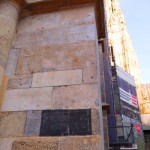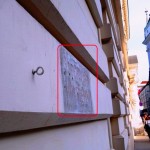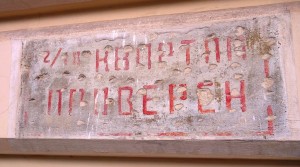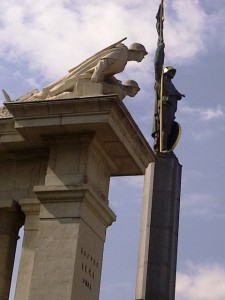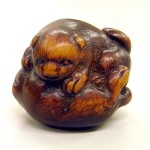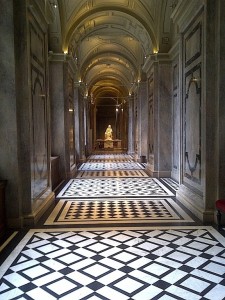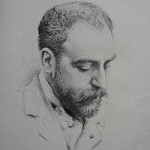“A gift consists not in what is done or given, but in the intention of the giver or doer.”
Seneca, Moral Essays, Volume III: de Beneficiis

When I first arrived in Beijing to study Chinese many years ago (we won’t mention how many), I was intimidated by the notion of having to find my way around a city where, because of my lack of Chinese, I had become virtually illiterate overnight. Back then, barely any signs were in Pinyin, let alone English. And when, after my two hour commute on public transportation and bicycles, I finally arrived at the Beijing Language and Cultural Institute early in the morning on day one of my language lessons, I made a quick note to self that I would always be able to recognize the entrance to my university (a Communist cookie-cutter monstrosity) by the gargantuan concrete Chairman Mao towering over the entrance.
I disembarked from bus 375 on day two to the horrific realization that Chairman Mao, in an omnipresent autocratic fashion only a person of his stature could muster, not only towered over one entrance but all the entrances of every single building along the avenue.
Surely not the most aesthetic structures but definitely making a point. Deceased politicians armed with faces that could launch daggers, Kalashnikov-wielding soldiers standing like launch-ready missiles on 20 ft tall pedestals and babushka-donning grandmothers who look so large and sturdy that not even the fiercest bull would take them on.
Nothing says welcome to our fatherland like the monstrous stern-faced monuments staring down all who dare to venture along the broad bare avenues of the communist capitals.
And after a while (and maybe a vodka or Sorghum wine or two) you start to see the charm of them a bit. Like Mao for instance. There he is. And there he is again. And again! (I know you). All the way up the road, Mao1, Mao2, Mao3, (you get the picture) lining up parade style, patiently waiting to usher little insignificant you into the big bad institutes of higher powers.
But those kind of constructions are for those places. Not for Vienna.
Well…
If you visited, and it was a gorgeous day (not like the past four we’ve recently had), and the fountains were active, you might have just missed it. Funny, isn’t it? Austrians who usually pay such close attention to detail manage to erect something that can’t always be seen. Now why would they want to do that? Coincidence?
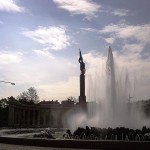
View from side of fountain and red army soldier at the Soviet Memorial in Vienna
The Stalinesque monument consists of a 12 meter tall Red Army soldier on Schwarzenberg Platz who stands atop a 20 meter tall stone pedestal, weapon slung over his shoulder as he guards over the square between Belvedere Castle and the Ring.
But why is he here?
At the end of World War II, just like in Berlin, Vienna was divided into four zones occupied by soldiers of the American, British, French and Russian armies. Stalin ordered the construction of the “Heroes’ Monument of the Red Army” (das Heldendenkmal der Roten Armee) immediately after the Russians took over the city on April 14, 1945. On August 19, 1945 the memorial was unveiled to commemorate the approximately 17,000 soldiers of the Russian Red Army who fell during the battle for Vienna in World War II.
The monument has many names which reflect the degree of public acceptance of the memorial – everything from outrage (sometimes ending in vandalism) to tacit acceptance. The names include: Soviet War Memorial, Heroes’ Monument of the Red Army, the Liberation Memorial, the Victory Memorial and Pea Memorial (referring to the 1000 tons of peas Stalin had ordered be sent to the city on May 1, 1945 to be distributed to Vienna’s starving inhabitants).
Inscribed in the memorial are the following words:
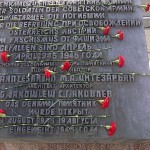
Memorial plaque draped in red carnations: “Monument to honor the soldiers of the Soviet army, who died for the liberation of Austria from fascism.”
Eternal glory to the heroes of the Red Army who fell in battle against the German fascist invaders for the freedom and Independence of the peoples of Europe.
Ewiger Ruhm den Helden der Roten Armee, die gefallen sind im Kampf gegen die deutsch-faschistischen Landräuber – für die Freiheit und Unabhängigkeit der Völker Europas.
And also in the middle of the columns, on a metal cube in Russian and German are the following words:
Monument to honor the soldiers of the Soviet army, who died for the liberation of Austria from fascism.
Denkmal zu Ehren der Soldaten der Sowjetarmee, die für die Befreiung Österreichs vom Faschismus gefallen sind.
Though more places were considered for the site of the memorial, Prater, for example, it isn’t hard to imagine why the Viennese would have suggested this spot as the perfect place for such a construction. I wasn’t along for the location tour in 1945 but I can imagine, in a supreme Austrian move of diplomacy, that the good gentlemen of the committee arranged for the large fountain also on the square to be turned off during the site tour. And they kept the high pressure stream fountain (Hochstrahlbrunnen) off throughout the construction period. Those darn fountains – always out of order. And since we’re doing a bit of construction work at this site anyway, why don’t we too use some prisoners of war to do some repair work on our old fountain.
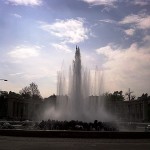
The Hochstrahlbrunnen (Fountain) almost perfectly hides the Red Army Soldier of the Soviet War Memorial on Schwarzenbergplatz
And lo and behold, shortly after the unveiling of the monument and not too long after all the hoopla died down, that fountain magically started working again. And man did it work. Larger and taller than ever! And when turned on full blast –oops! – it might just cover up the soldier behind it a wee little bit so that you can’t really see him from the Ringstrasse at all. Now that’s diplomacy.
Some quick facts about the monument:
- the Red Army soldier was made in Vienna (Erdberger Lände) from 15 tons of bronze;
- the columns are made of 300 m2 of Engelsberger marble;
- in 2007 and on June 24, 2014, Russian President Vladimir Putin laid flowers at the memorial and thanked the Viennese for maintaining it;
- from April 12, 1946 until July 18, 1956, the southern area of the Schwarzenberg Square where the memorial is located, was called Stalinplatz (Stalin Square);
- on the day of unveiling the monument, the memorial was given to the Vienna City Administration to watch over and take care of;
- soldiers of the red army who were originally buried there were eventually exhumed and buried at the Vienna Central Cemetery;
- a Russian tank that was originally displayed was moved to the Vienna Military Museum (Heeresgeschichtlichen Museum);
- the memorial underwent extensive restoration work in 2009 paid for by the city of Vienna;
- in 1947 two people – a 19 year old man and a 25 year old woman – who were members of a Nazi underground group called the Werewolf Group — were charged with planning to place a bomb at the memorial;
- on April 15, 1958, the corpse of Ilona Faber, was found behind the columns. Her killer was never found;
- on August 18, 1962, a bag with bomb material was found and defused. The bomb could be traced to Italy.
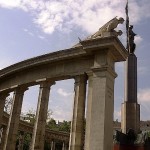
Side View of the Soviet War Memorial
The Fountain:
On the edge of the pool are 365 small water spout fountains symbolizing the days of the year. The six fountains between the edge of the pool and the inner island along with the island itself represent the seven days of the week. The 12 high water jets represent the months, the 24 low ones, the hours of the day and the 30 in the middle of the island, the days of the month. The original water jets from 1873 had only a tall jet stream for the year, and four jet streams on the island for the seasons as well as the 365 border water spouts for the days of the year.
At night the fountain lights up red, pink, yellow, violet, blue and green.

If you are impressed with Austrian diplomacy and want to learn from the masters, then I recommend you check out the Diplomatic Academy here: The Diplomatic Academy of Vienna
Read more here:
Wikimapia of Soviet War Memorial with aerial view:Wikipedia Entry on Russian Memorial
(Note the interesting different points of view in the English and German Wikipedia entries)
German Wikipedia entry of Soviet War Memorial:Wikipedia Entry on Red Army Memorial
English Wikipedia entry of Soviet War Memorial:Wikipedia Entry on Soviet War Memorial
Article from Austrian daily newspaper, die Presse, from April 13, 2012, entitled “Schwarzenberg Square – Russian Memorial covered in Paint” http://diepresse.com/home/panorama/wien/749123/Wien_RussenDenkmal-mit-Farbe-uberschuttet-
Article from Austrian magazine, News, from May 24, 2007, entitled, “Heroes’ Memorial of the Red Army: 18,000 Soldiers died in the Liberation of Vienna” http://www.news.at/a/heldendenkmal-roten-armee-18-000-soldaten-befreiung-wiens-174106
Swiss Radio and TV Article from January 13, 2014 entitled, “The Russian Memorial: A Gift of the Red Army to Itself” http://www.srf.ch/kultur/im-fokus/weltbewegende-geschenke/das-russendenkmal-ein-geschenk-der-roten-armee-an-sich-selbst
Wikipedia Entry about the Hochstrahlbrunnen, High Powered Jet Fountain on Schwarzenberg Platz: http://de.wikipedia.org/wiki/Hochstrahlbrunnen
Lower Austrian Public TV (ORF) article from March 21 entitled “1000 Tons of Peas” http://noev1.orf.at/magazin/daheiminnoe/schallaburg/stories/erbsen/index.html
 When accompanying a group of US high school students to Berlin, the disappointment was almost palpable. We were in Berlin and they wanted to see the remnants of the wall. Instead, we showed them a brick trail leading past Brandenburger Gate. Yes, there’s a small part of the wall preserved as an exhibit that you can view from an old guard tower. We did that. But it wasn’t up close and personal. Let’s face it. The Marble Kids Museum in Raleigh, NC had a chunk of the wall that seemed bigger than we could find in Berlin.
When accompanying a group of US high school students to Berlin, the disappointment was almost palpable. We were in Berlin and they wanted to see the remnants of the wall. Instead, we showed them a brick trail leading past Brandenburger Gate. Yes, there’s a small part of the wall preserved as an exhibit that you can view from an old guard tower. We did that. But it wasn’t up close and personal. Let’s face it. The Marble Kids Museum in Raleigh, NC had a chunk of the wall that seemed bigger than we could find in Berlin.

